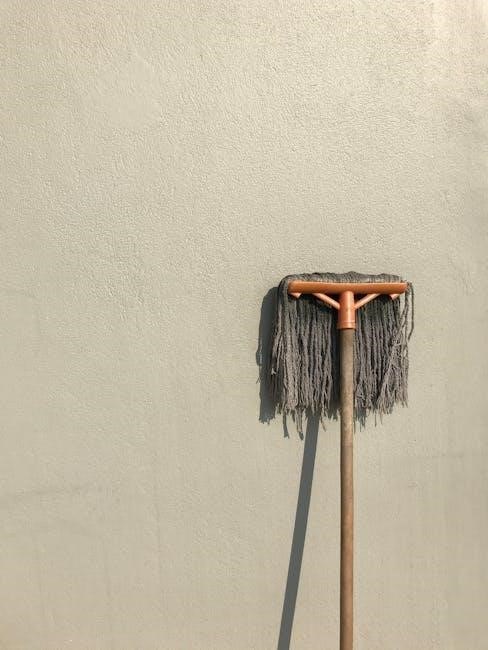cleaning company equipment list pdf
This section introduces the fundamental aspects of cleaning company equipment list PDF, highlighting essential tools, efficiency, and organization for professional cleaning services․
1․1 Importance of Having the Right Cleaning Equipment
Using the right cleaning equipment is crucial for efficiency, safety, and effectiveness․ Proper tools ensure thorough cleaning, protect surfaces from damage, and reduce labor time․ They also prevent the spread of contaminants and improve worker safety․ Investing in quality equipment enhances professionalism and customer satisfaction, making it a cornerstone of a successful cleaning operation․ A well-equipped team can handle diverse cleaning tasks with precision and reliability․
1․2 Overview of Essential Cleaning Equipment Categories
Cleaning equipment can be categorized into manual, mechanical, and specialized tools․ Manual equipment includes mops, brooms, and scrub brushes for basic tasks․ Mechanical equipment, like vacuum cleaners and floor polishers, enhances efficiency for larger areas․ Specialized tools, such as pressure washers and industrial vacuums, tackle specific jobs․ Each category plays a vital role in maintaining cleanliness and organization in commercial and residential settings, ensuring all tasks are addressed effectively․
Essential Cleaning Equipment List
This section provides a detailed list of essential cleaning tools and supplies, including mops, buckets, vacuum cleaners, and trolleys, ensuring effective and efficient cleaning operations․
2․1 Manual Cleaning Equipment
Manual cleaning equipment includes essential tools like mops, buckets, brooms, and dustpans, which are vital for everyday cleaning tasks․ These handheld or simple devices require physical effort but are cost-effective and indispensable for maintaining cleanliness․ They are often used for small-scale operations or areas where mechanical equipment is impractical․ Mops and buckets are perfect for floor cleaning, while brooms and dustpans handle dust and debris efficiently, ensuring thorough manual cleaning․
2․2 Mechanical Cleaning Equipment
Mechanical cleaning equipment enhances efficiency and scalability for large-scale operations․ Key machinery includes vacuum cleaners, floor polishers, and pressure washers, designed for heavy-duty tasks․ Industrial vacuum cleaners offer deep cleaning, while floor polishers maintain polished surfaces․ Pressure washers are ideal for outdoor or industrial areas, removing stubborn stains․ These tools streamline cleaning processes, ensuring thorough results in less time, making them indispensable for professional cleaning services and maintaining high standards of cleanliness in various environments․

Cleaning Supplies and Materials
Cleaning supplies include essential chemicals like all-purpose cleaners, disinfectants, and glass cleaners, along with disposable items such as microfiber cloths and gloves, ensuring effective and safe cleaning operations․
3․1 Basic Cleaning Chemicals
Basic cleaning chemicals include all-purpose cleaners, glass cleaners, disinfectants, and degreasers․ These essentials effectively tackle dirt, grime, and germs, ensuring surfaces are clean and hygienic․ All-purpose cleaners are versatile for daily use, while disinfectants are crucial for sanitizing high-touch areas․ Glass cleaners provide streak-free results, and bleach is used for deep sanitization․ These chemicals form the backbone of any cleaning operation, ensuring efficiency and safety․
3․2 Disposable Cleaning Supplies
Disposable cleaning supplies, such as gloves, microfiber cloths, and garbage bags, are essential for maintaining hygiene and efficiency․ Disposable gloves protect hands from harsh chemicals, while microfiber cloths effectively clean surfaces without leaving residue․ Garbage bags ensure waste is handled safely․ These supplies are cost-effective, prevent cross-contamination, and are widely available․ They are included in most cleaning company equipment list PDF guides for their versatility and convenience․
Specialized Cleaning Tools
Specialized cleaning tools like industrial vacuum cleaners and high-pressure washers are designed for heavy-duty tasks․ These tools, such as the DB760A-B and DB760-MC models, offer advanced features for efficient cleaning․

4․1 Industrial Vacuum Cleaners
Industrial vacuum cleaners, such as the DB760A-B and DB760-MC models, are heavy-duty tools designed for large-scale cleaning tasks․ Equipped with dual-brush plates and high cleaning efficiency, these vacuums are ideal for commercial and industrial environments․ They feature adjustable power settings, robust construction, and advanced suction capabilities, making them essential for maintaining cleanliness in demanding settings․ These vacuums are a cornerstone of professional cleaning operations, ensuring reliability and efficiency in tough environments․
4․2 High-Pressure Washers
High-pressure washers are powerful tools for heavy-duty cleaning tasks, ideal for removing stubborn dirt, grime, and stains from surfaces․ With models like the DB760A-B offering 24VDC voltage and 2110W power, these devices deliver high efficiency and durability․ They are commonly used for industrial and commercial cleaning, ensuring deep sanitation of large areas․ Their robust design and adjustable pressure settings make them a vital asset for professional cleaning operations, ensuring thorough and reliable results in demanding environments․

Safety and Protective Gear
Safety and protective gear are crucial for preventing injuries and ensuring compliance with workplace safety standards․ Essential items include disposable gloves, safety glasses, and respiratory masks, providing optimal protection during cleaning tasks․
5․1 Personal Protective Equipment (PPE)
PPE is essential for protecting cleaning staff from harmful substances․ Key items include disposable gloves, rubber gloves, goggles, face shields, and aprons․ These protect against chemicals, biological agents, and physical hazards, ensuring safety during cleaning tasks․ Always include PPE in your cleaning company equipment list PDF for compliance and worker safety․
5․2 Safety Guidelines for Equipment Use
Adhering to safety guidelines is crucial for safe equipment operation․ Always inspect equipment before use, identify potential hazards, and ensure proper ventilation․ Train staff on correct usage and maintenance․ Use protective gear and follow manufacturer instructions․ Regularly check for worn or damaged parts and store equipment safely․ These practices minimize risks and ensure compliance with safety standards in your cleaning company equipment list PDF․

Cleaning Equipment Maintenance
Regular equipment maintenance ensures efficiency and longevity․ Schedule routine inspections, clean machinery, and lubricate moving parts․ Address repairs promptly to prevent downtime and extend equipment lifespan․
6․1 Tips for Extending Equipment Lifespan
Follow manufacturer guidelines for maintenance and usage․ Regularly lubricate moving parts and inspect for wear․ Store equipment in dry, clean areas to prevent rust․ Train staff to operate machines correctly․ Address minor repairs promptly to avoid major breakdowns․ Use appropriate settings for different surfaces to reduce strain․ Keep maintenance records to track service history and ensure consistency․ Proper care extends equipment lifespan and maintains efficiency․
6․2 Regular Maintenance Checklist
A regular maintenance checklist ensures optimal equipment performance․ Lubricate moving parts monthly, inspect hoses and belts for wear, and clean filters weekly․ Replace worn brushes and check battery levels in cordless devices․ Schedule professional servicing annually for complex machinery․ Keep a log of maintenance activities to track equipment health․ Address any issues promptly to prevent breakdowns and ensure longevity․ This routine supports operational efficiency and extends equipment durability․

Budgeting for Cleaning Equipment
Effective budgeting for cleaning equipment ensures affordability and quality․ Plan costs, prioritize needs, and explore cost-effective options to optimize your company’s financial investments very wisely․
7․1 Cost-Effective Equipment Options
Exploring cost-effective equipment options is crucial for budget-friendly cleaning operations․ Consider manual tools like mops and brooms, which are affordable and durable․ Entry-level vacuum cleaners and reusable cleaning supplies, such as microfiber cloths, reduce long-term expenses․ Additionally, buying in bulk or opting for second-hand equipment can lower costs without compromising efficiency․ Prioritize essentials and balance quality with affordability to maximize your cleaning company’s budget․
7․2 Long-Term Investment in Quality Equipment
Investing in high-quality cleaning equipment ensures durability and efficiency, reducing long-term costs․ Premium tools like industrial vacuums and floor polishers offer superior performance and longevity․ While initial expenses may be higher, reliable equipment minimizes maintenance and extends lifespan․ Prioritizing quality equipment supports consistent service delivery and enhances customer satisfaction, making it a strategic decision for sustainable business growth․
Eco-Friendly Cleaning Equipment
Eco-friendly cleaning equipment includes energy-efficient tools and sustainable materials, reducing environmental impact while maintaining effectiveness․ Options like steam cleaners and biodegradable supplies promote greener cleaning practices․
8․1 Environmentally Safe Cleaning Solutions
Environmentally safe cleaning solutions include biodegradable chemicals and natural alternatives that reduce environmental impact․ These eco-friendly products minimize toxicity and promote sustainable cleaning practices․ Examples are microfiber cloths and steam cleaners, which effectively clean without harsh chemicals․ Incorporating these solutions helps businesses maintain high standards while supporting environmental conservation, making them essential for modern cleaning operations and aligning with eco-conscious values for a sustainable future․
8․2 Energy-Efficient Cleaning Tools
Energy-efficient cleaning tools are designed to reduce power consumption while maintaining performance․ Examples include low-energy vacuum cleaners, battery-operated devices, and eco-mode pressure washers․ These tools optimize energy use, lowering operational costs and environmental impact․ Investing in energy-efficient equipment supports sustainability goals and enhances a company’s commitment to reducing its carbon footprint, making them a smart choice for modern cleaning operations․

Digital Tools for Cleaning Management
Digital tools streamline cleaning operations through software for inventory management and apps for task scheduling, enhancing efficiency and organization in modern cleaning businesses․
9․1 Software for Equipment Inventory Management
Software for equipment inventory management helps cleaning companies track and organize their tools efficiently․ It allows businesses to monitor stock levels, automate reordering, and generate detailed reports․ Key features include real-time tracking, barcode scanning, and customizable dashboards․ This technology ensures that all equipment is accounted for, reducing losses and improving operational efficiency․ By integrating with other systems, it streamlines workflows and supports scalable growth for cleaning operations․
These tools are essential for maintaining a well-organized and resource-efficient cleaning business․

9․2 Apps for Cleaning Task Scheduling
Apps for cleaning task scheduling streamline operations by enabling businesses to organize and assign tasks efficiently․ These tools allow managers to create schedules, track progress, and notify staff in real-time․ Features like task assignment, due date reminders, and performance tracking ensure accountability․ Such apps enhance productivity, reduce misunderstandings, and improve customer satisfaction by ensuring all cleaning tasks are completed on time and to standard․
Comprehensive Cleaning Company Equipment PDF Guide
This guide provides a detailed overview of essential cleaning tools and supplies, offering a downloadable checklist for efficient equipment management and organization․
10․1 How to Create a Detailed Equipment List
Start by identifying essential cleaning tools and supplies, categorizing them into manual, mechanical, and specialized equipment․ Include quantities, preferred brands, and suppliers․ Consider frequency of use, budget constraints, and storage needs․ Prioritize must-have items like vacuums, mops, and PPE․ Add optional equipment based on service expansion plans․ Finally, review and update the list regularly to ensure accuracy and relevance for your cleaning operations․
10․2 Downloadable Equipment Checklist
A downloadable equipment checklist provides a practical and organized way to manage your cleaning company equipment list PDF․ It includes essential items like vacuums, mops, and PPE, ensuring nothing is overlooked․ Customize templates to fit your business needs, track inventory, and maintain efficiency․ Accessible formats allow easy sharing and updates, helping you stay prepared for any cleaning task or client request․